.

Is It Possible to Grow Weed in Space?
As humans become more proficient in space travel, cosmic agriculture will have to keep up to make deep space exploration a possibility. NASA is currently growing vegetables at the International Space Station, but does weed have what it takes to survive in space? Discover how growing cannabis in space could become a reality in the future.
Contents:
Growing weed in space might seem like something out of a stoner sci-fi flick, but as space exploration continues to ramp up, it could one day become a reality. While the minds of our greatest aerospace engineers are currently working on more pressing projects, such as extending the presence of the human race to the moon, mars, and beyond, efforts at NASA are also focusing on the cultivation of plants in space. While research currently surrounds plants used for sustenance, it’s likely that as space exploration becomes more advanced, cannabis will inevitably join the likes of salad vegetables in cruising amongst the stars. Continue reading to discover the ins and outs of cosmic cannabis cultivation.
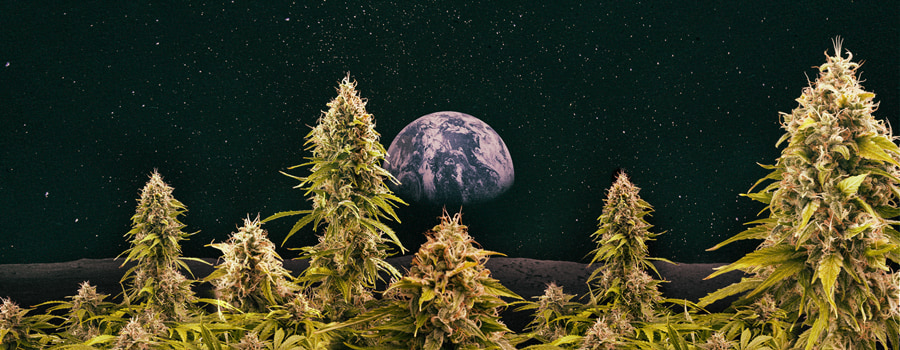
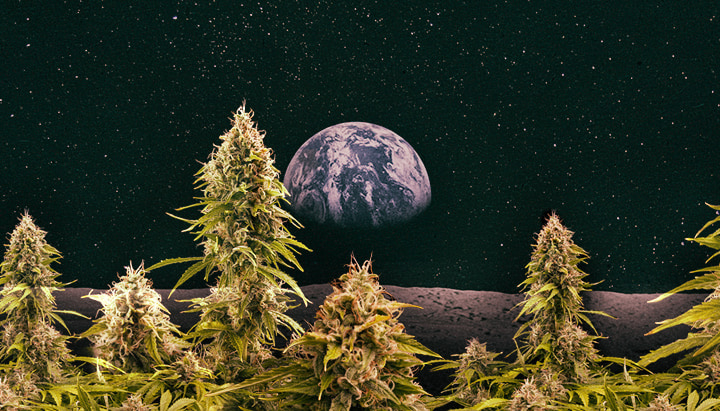
Is It Possible to Grow Cannabis in Space?
There are two factors we need to consider when it comes to growing weed in space: the physical environment and man-made laws. Cannabis has faced periods of prohibition throughout human history on Earth, which continues today in many countries. However, the law works differently in space. The United Nations Outer Space Treaty[1], agreed upon in 1966, lays the groundwork for international conduct in space. Though the document allows for the exploration of space by all states, affirms that the moon and all celestial bodies shall be used for only peaceful purposes, and forbids the deployment of nuclear weapons in space and on other planets, it fails to mention anything about weed.
Adding to this, astronauts are forbidden from smoking on the International Space Station (ISS); those on the Apollo missions also had to adhere to this rule. Many weed enthusiasts fell under the impression that the ISS permitted the smoking of cannabis following the release of a picture in 2018 of astronaut Chris Hadfield holding what appeared to be a large bag of nugs. However, this image turned out to be a hoax; the original featured Hadfield holding a bag of Easter eggs instead. As space exploration develops, different states will likely draw up legislation that either condemns or legalizes cannabis cultivation on deep space voyages.
Now, what about the environment? Life cannot exist in the vacuum of space itself. However, human spacecraft have created an artificial environment in which both humans and plant life can survive. The Vegetable Production System, also known as Veggie, is a small space garden currently operating on the ISS. While astronauts currently stationed there receive shipments of freeze-dried foods, the nutrients within these items degrade over time, making them unsuitable for deep space exploration. To counteract scurvy and other issues that manifest owing to a lack of fruits and vegetables in the diet, NASA hopes Veggie will set the stage for space gardens of the future.
So far, Veggie has successfully cultivated lettuce, cabbage, mustard, kale, and zinnia flowers in space. Because these plants require the same core inputs as cannabis to survive and thrive, it’s certainly possible to raise pot plants onboard spacecraft.
How Would Zero Gravity Affect the Growth of Cannabis Plants?
Strictly speaking, because of its size and the fact that it rotates and remains in low Earth orbit, the ISS is a microgravity environment—not a zero-gravity environment. The same also applies to vessels out in deep space, as some gravitational forces still exist, but just have a far less pronounced effect on organisms than they do on Earth or other celestial bodies. With that in mind, plants are gravitropic forms of life, and the force of gravity on Earth plays an important part in how they grow.
Plant roots exhibit positive gravitropism, meaning they grow downwards after sensing gravity. Conversely, plant shoots display negative gravitropism and therefore grow upwards in the presence of Earth’s gravity. While the lack of gravity onboard the ISS and on other spacecraft could make growing weed trickier, the success of Veggie shows that it’s certainly possible. Though the crops currently grown by the programme are less branching than cannabis, training the aerial parts of the plant and manipulating root growth are viable options.
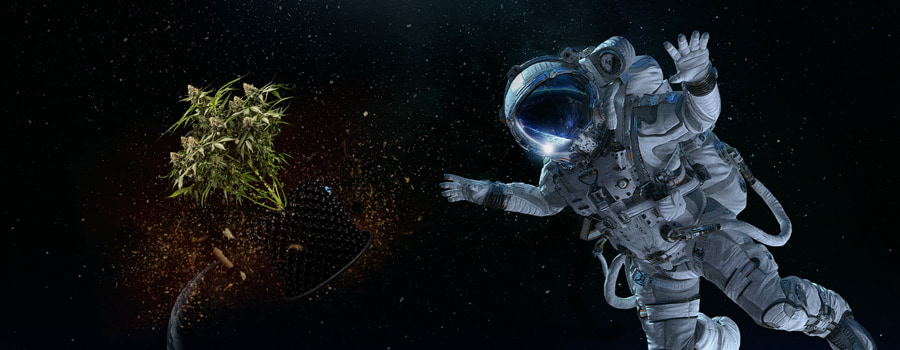
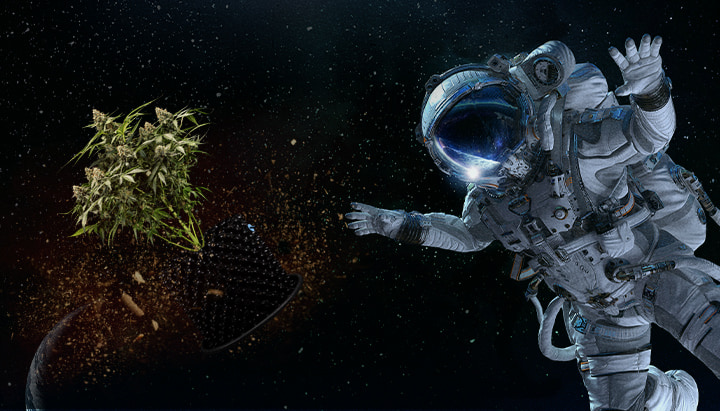
What Are the Other Challenges of Growing Cannabis in a Space Environment?
With plant gravitropism in mind, what other big issues could botanical astronauts face when it comes to growing weed beyond Earth?
Setups for Growing Weed in Space
Plants require much different management when grown in space. With little gravity, those planted in conventional pots would leave soil floating all over the place. To counter this, the Veggie programme essentially grows plants in an enclosed pillow-like structure filled with a clay-based growing medium. A solution that hydrates and nourishes plants circulates this system, keeping everything in place and preventing things from getting messy. This system also distributes water in a way that prevents roots from becoming engulfed by air, and stops water from forming bubbles in the microgravity environment.
The Problem of Gravitropism for Plants in Space
The gravitropism issue will also prevent conventional earthly setups from working in space. However, the Veggie pillow system also solves this problem by encasing plant roots. Regardless of the direction in which they grow, they’re restricted to the pillow itself. As plants mature, they’ll expand across the entire growing medium, albeit in a more haphazard way than they would when subject to Earth’s gravity.
Lighting for Plants Growing Beyond Earth
Without exposure to direct sunlight, weed plants on the spacecraft of the future will require artificial lighting. Solar panels are now the chief way of fuelling modern spacecraft. Since the United States launched the Vanguard 1 satellite in 1958, the efficiency of solar panels has doubled from 9%, while the cost of manufacturing has plummeted. With institutions such as the European Space Agency now toying with the idea of using solar panel-equipped satellites to harvest the sun’s energy and beam it back down to Earth, innovators are seeking to send efficiency surging further with new technology. A prototype device developed in Australia that harvests infrared radiation instead of sunlight has proven around 10,000 times more powerful[2] than conventional solar systems. With these advances in mind, future spacecraft won’t have any issues running LEDs—one of the most efficient types of lighting available in plant cultivation—in their onboard gardens.
Water and Nutrients for Plants Grown in Space
The ISS boasts a regenerative water system, one that could also prove viable for space gardens in the future. The system recycles urine, sweat, and condensation to produce water. In the context of a space garden, water lost through plant transpiration would work itself back into the growing medium. Nutrient supplies certainly pose a bigger challenge, and scientists will need to figure out a method of closed-loop space agriculture to solve this problem.
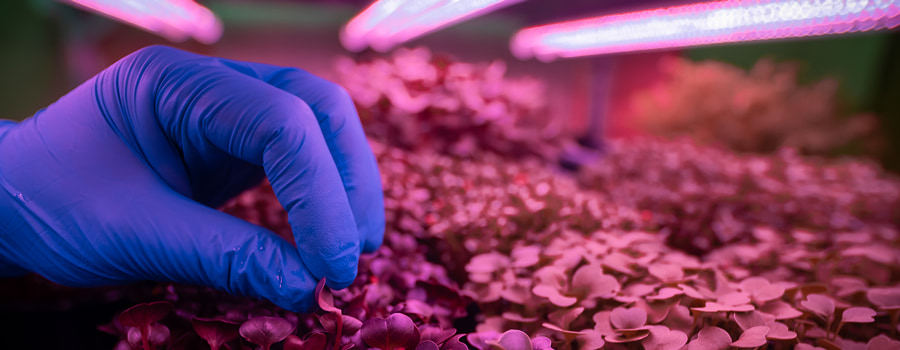
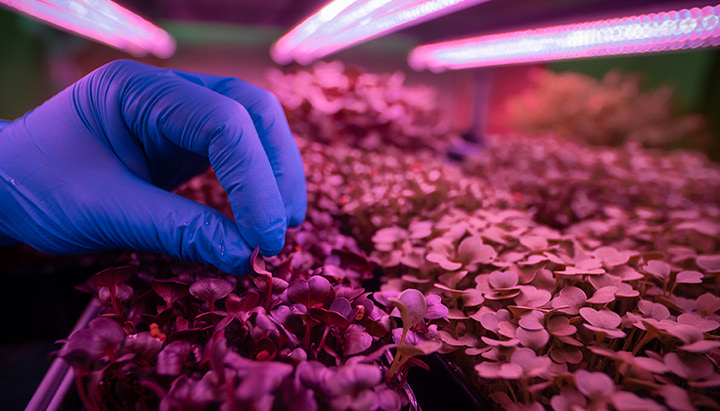
Are There Any Potential Benefits to Growing Cannabis in Space?
There are certainly many key issues to address before growing weed in space. But are there any benefits to cultivating cannabis amongst the stars?
Enhanced Phytochemical Contents
Cannabis contains a wide range of desirable phytochemicals. Among them, cannabinoids and terpenes are the most economically important. On Earth, cannabis plants often increase the production of these compounds in response to stress, such as exposure to UV rays. Some researchers speculate that the combination of increased exposure to radiation in space and a microgravity environment could stress out plants enough to produce more of these chemicals, possibly resulting in stronger and more flavourful cannabis.
Advancing Space Agriculture
While Veggie has only produced a handful of crops, the programme aims to incorporate the likes of tomatoes, beans, peppers, and berries. Further down the line, it's likely that cultured proteins and 3D printed foods will also make an appearance on deep space vessels. Nutrient-dense food certainly holds priority when it comes to the advancement of space agriculture. While cannabis might fall to the wayside for quite some time, the innovations made in other areas of space cultivation will likely make growing weed in space much easier and efficient if it's ever deemed worthwhile.
Economic Opportunities
The development of successful space cannabis programmes would give rise to exciting new economic opportunities. The possibility could attract investors that would have an indirect impact on the development of space travel as a whole. The novelty of space-grown cannabis, while likely to be extremely expensive, could also attract buyers down on Earth. The first buds grown in space would certainly go down in the cannabis history books.
To Boldly Grow Where No Man Has Grown Before
At first mention, growing cannabis in space sounds like nothing more than the kind of talk you’d expect when surrounded by naive smokers. However, space weed could become a reality at some point in the future. While space agriculture will inevitably focus on food crops for the foreseeable future, the advancement of cosmic gardens could lead to the production of cannabis onboard future spacecraft. You never know, the weed lovers of the future may develop a preference for space-grown weed!
- The Outer Space Treaty https://www.unoosa.org
- Beam me down: can solar power from space help solve our energy needs? | Science | The Guardian https://www.theguardian.com








































